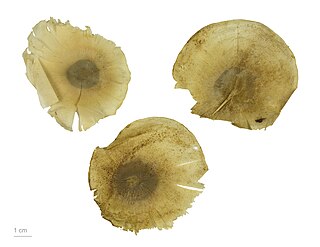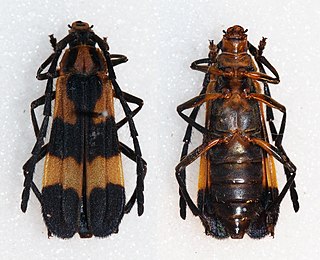
Pouteria is a genus of flowering trees in the gutta-percha family, Sapotaceae. The genus is widespread throughout the tropical Americas, with outlier species in Cameroon and Malesia. It includes the canistel, the mamey sapote, and the lucuma. Commonly, this genus is known as pouteria trees, or in some cases, eggfruits.

Crypturellus is a genus of tinamous containing mostly forest species. However, there are the odd few that are grassland or steppe tinamous. The genus contains 21 species.

Aspidosperma is a genus of flowering plant in the family Apocynaceae, first described as a genus in 1824. It is native to South America, Central America, southern Mexico, and the West Indies.

Oenocarpus is a genus of pinnate-leaved palms (Arecaceae) native to Trinidad, southern Central and tropical South America. With nine species and one natural hybrid, the genus is distributed from Costa Rica and Trinidad in the north to Brazil and Bolivia in the south.

Micropholis is genus of trees in the family Sapotaceae, described in 1891.
Dercylus is a genus in the beetle family Carabidae. There are more than 30 described species in Dercylus, found primarily in Mexico, Central America, and South America.

Mionochroma is a genus of typical longhorn beetles in the family Cerambycidae. There are more than 20 described species in Mionochroma, found in the Neotropics.
Caperonotus is a genus of typical longhorn beetles in the family Cerambycidae. There are at least four described species in Caperonotus, found in Brazil, Peru, and French Guiana.
Chlorethe is a genus in the longhorn beetle family Cerambycidae. There are at least four described species in Chlorethe, found in South America.

Orthostoma is a genus in the longhorn beetle family Cerambycidae. There are at least three described species in Orthostoma, found in South America.

Pronuba is a genus of long-horned beetles in the family Cerambycidae. There are about five described species in Pronuba, found in Central and South America.

Oreodera is a genus of long-horned beetles in the family Cerambycidae. Oreodera is in the subfamily Lamiinae, the flat-faced longhorns. There are more than 100 described species in Oreodera, found in Central and South America.

Pelidnota is a genus of beetles of the family Scarabaeidae. There are more than 180 described species in Pelidnota, found in the Neotropics.

Achryson immaculipenne is a species in the longhorned beetle family Cerambycidae. It is found in South American, and is known from Brazil, Paraguay, French Guiana, Venezuela, Bolivia, Argentina, Ecuador, and Colombia.
Chlorethe ingae is a species in the longhorn beetle family Cerambycidae. It is found in Bolivia, Brazil, Ecuador, French Guiana, and Peru.

Cosmoplatidius abare is a species in the longhorn beetle family Cerambycidae. It is found in Bolivia, Brazil, and Peru.
Cosmoplatidius lycoides is a species in the longhorn beetle family Cerambycidae, found in Brazil, Bolivia, French Guiana, and Guyana.
Cosmoplatidius simulans is a species in the longhorn beetle family Cerambycidae. It is found in Ecuador, French Guiana, Brazil, Bolivia, and Peru.

Odontadenia is a genus of plant in the family Apocynaceae, first described as a genus in 1841. It is native to southern Mexico, Central America, South America, and the West Indies.
- Odontadenia anomala(Van Heurck & Müll.Arg.) J.F.Macbr. - Peru, Bolivia
- Odontadenia campanulataJ.F.Morales - Colombia
- Odontadenia funigeraWoodson - Venezuela, Colombia, Ecuador, Peru, Brazil
- Odontadenia geminata(Hoffmanns. ex Roem. & Schult.) Müll.Arg. - 3 Guianas, Venezuela, Colombia, Ecuador, Peru, Bolivia, N Brazil
- Odontadenia glaucaWoodson - Amazonas State in S Venezuela
- Odontadenia gracilipes(Stadelm.) Woodson - Minas Gerais
- Odontadenia hypoglauca(Stadelm.) Müll.Arg. - Bolivia, Brazil
- Odontadenia killipiiWoodson - French Guiana, Venezuela, Colombia, Ecuador, Peru, N Brazil
- Odontadenia kochiiPilg. - Guyana, Venezuela, Colombia, Ecuador, Peru, N Brazil
- Odontadenia laxiflora(Rusby) Woodson - Peru, Bolivia, N Brazil
- Odontadenia lutea(Vell.) Markgr. - Peru, Bolivia, Brazil
- Odontadenia macrantha(Roem. & Schult.) Markgr. - Oaxaca, Chiapas, Central America, Trinidad & Tobago, 3 Guianas, Venezuela, Colombia, Ecuador, Peru, Brazil
- Odontadenia markgrafianaJ.F.Morales - French Guiana, N Brazil
- Odontadenia matogrossanaJ.F.Morales - Goiás, Mato Grosso
- Odontadenia nitida(Vahl) Müll.Arg. - Trinidad & Tobago, 3 Guianas, Venezuela, Colombia, Ecuador, Peru, Brazil, Bolivia
- Odontadenia perrottetii(A.DC.) Woodson - Venezuela, Colombia, Brazil, Bolivia, Guyana, French Guiana
- Odontadenia polyneura(Urb.) Woodson - Hispaniola
- Odontadenia puncticulosa(Rich.) Pulle - Central America, 3 Guianas, Venezuela, Colombia, Ecuador, Peru, Brazil, Bolivia
- Odontadenia stemmadeniifoliaWoodson - Venezuela, Colombia, Ecuador, Peru, Brazil
- Odontadenia verrucosa(Willd. ex Roem. & Schult.) K.Schum. ex Markgr. - 3 Guianas, Venezuela, Colombia, Ecuador, Peru, Brazil, Bolivia, Panama, Costa Rica, Nicaragua
- Odontadenia cuspidataRusby = Mandevilla cuspidata(Rusby) Woodson
- Odontadenia duckeiMarkgr. = Mandevilla pohliana(Stadelm.) A.H.Gentry
- Odontadenia glandulosa(Ruiz & Pav.) K.Schum. = Mandevilla glandulosa(Ruiz & Pav.) Woodson
- Odontadenia macrocalyx(Müll.Arg.) Miers = Tabernaemontana macrocalyxMüll.Arg.
Euthima is a genus of flat-faced longhorns in the beetle family Cerambycidae. There are at least three described species in Euthima.













